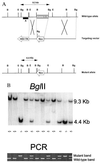Galanin regulates prolactin release and lactotroph proliferation
- PMID: 9770544
- PMCID: PMC22889
- DOI: 10.1073/pnas.95.21.12671
Galanin regulates prolactin release and lactotroph proliferation
Abstract
The neuropeptide galanin is predominantly expressed by the lactotrophs (the prolactin secreting cell type) in the rodent anterior pituitary and in the median eminence and paraventricular nucleus of the hypothalamus. Prolactin and galanin colocalize in the same secretory granule, the expression of both proteins is extremely sensitive to the estrogen status of the animal. The administration of estradiol-17beta induces pituitary hyperplasia followed by adenoma formation and causes a 3,000-fold increase in the galanin mRNA content of the lactotroph. To further study the role of galanin in prolactin release and lactotroph growth we now report the generation of mice carrying a loss-of-function mutation of the endogenous galanin gene. There is no evidence of embryonic lethality and the mutant mice grow normally. The specific endocrine abnormalities identified to date, relate to the expression of prolactin. Pituitary prolactin message levels and protein content of adult female mutant mice are reduced by 30-40% compared with wild-type controls. Mutant females fail to lactate and pups die of starvation/dehydration unless fostered onto wild-type mothers. Prolactin secretion in mutant females is markedly reduced at 7 days postpartum compared with wild-type controls with an associated failure in mammary gland maturation. There is an almost complete abrogation of the proliferative response of the lactotroph to high doses of estrogen, with a failure to up-regulate prolactin release, STAT5 expression or to increase pituitary cell number. These data further support the hypothesis that galanin acts as a paracrine regulator of prolactin expression and as a growth factor to the lactotroph.
Figures






Similar articles
-
Galanin regulates basal and oestrogen-stimulated lactotroph function.Nature. 1993 Aug 5;364(6437):529-32. doi: 10.1038/364529a0. Nature. 1993. PMID: 7687748
-
Function of galanin in the anterior pituitary of estrogen-treated Fischer 344 rats: autocrine and paracrine regulation of prolactin secretion.Endocrinology. 1998 May;139(5):2452-8. doi: 10.1210/endo.139.5.6025. Endocrinology. 1998. PMID: 9564857
-
Signalling pathways mediating secretory and mitogenic responses to galanin and pituitary adenylate cyclase-activating polypeptide in the 235-1 clonal rat lactotroph cell line.J Neuroendocrinol. 1996 Jun;8(6):457-64. doi: 10.1046/j.1365-2826.1996.04747.x. J Neuroendocrinol. 1996. PMID: 8809676
-
Targeted disruption of the murine galanin gene.Ann N Y Acad Sci. 1998 Dec 21;863:22-47. doi: 10.1111/j.1749-6632.1998.tb10681.x. Ann N Y Acad Sci. 1998. PMID: 9928157 Review.
-
Galanin in normal and hyperplastic anterior pituitary cells. From pituitary tumor cell lines to transgenic mice.Ann N Y Acad Sci. 1998 Dec 21;863:48-55. doi: 10.1111/j.1749-6632.1998.tb10682.x. Ann N Y Acad Sci. 1998. PMID: 9928158 Review.
Cited by
-
The alveolar switch: coordinating the proliferative cues and cell fate decisions that drive the formation of lobuloalveoli from ductal epithelium.Breast Cancer Res. 2006;8(2):207. doi: 10.1186/bcr1411. Epub 2006 Apr 25. Breast Cancer Res. 2006. PMID: 16677418 Free PMC article. Review.
-
Single-Cell Transcriptomics Identifies Pituitary Gland Changes in Diet-Induced Obesity in Male Mice.Endocrinology. 2024 Jan 16;165(3):bqad196. doi: 10.1210/endocr/bqad196. Endocrinology. 2024. PMID: 38146776 Free PMC article.
-
Activation of the galanin receptor 2 (GalR2) protects the hippocampus from neuronal damage.J Neurochem. 2007 Feb;100(3):780-9. doi: 10.1111/j.1471-4159.2006.04239.x. J Neurochem. 2007. PMID: 17263796 Free PMC article.
-
Increased intake of ethanol and dietary fat in galanin overexpressing mice.Alcohol. 2009 Dec;43(8):571-80. doi: 10.1016/j.alcohol.2009.09.025. Alcohol. 2009. PMID: 20004335 Free PMC article.
-
Endogenous galanin protects mouse hippocampal neurons against amyloid toxicity in vitro via activation of galanin receptor-2.J Alzheimers Dis. 2011;25(3):455-62. doi: 10.3233/JAD-2011-110011. J Alzheimers Dis. 2011. PMID: 21471641 Free PMC article.
References
-
- Goluboff L G, Ezrin C. J Clin Endocrinol Metab. 1969;29:1533–1538. - PubMed
-
- Orgnero-de-Gaisan E M, Maldonado C A, Aoki A. Histochem J. 1993;25:150–165. - PubMed
-
- Haggi E S, Torres A I, Maldonado C A, Aoki A. J Endocrinol. 1986;111:367–373. - PubMed
-
- Aoki A, de Gaisan E O, Pasolli H A, Torres A I. Exp Clin Endocrinol Diabetes. 1996;104:256–262. - PubMed
-
- Bakay L. J Neurosurg. 1950;7:240–255. - PubMed
Publication types
MeSH terms
Substances
Grants and funding
LinkOut - more resources
Full Text Sources
Other Literature Sources
Molecular Biology Databases
Miscellaneous

